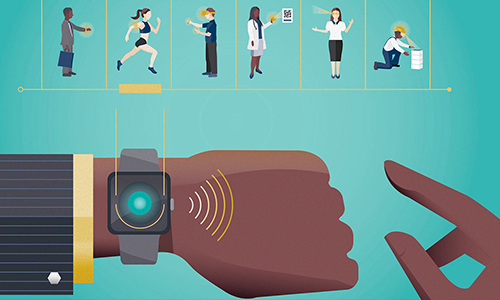Wearable devices for business vs. fitness
February 5, 2018
Source: Tech Republic
 869
869

Wearables, like smartwatches and fitness trackers, are popular with business professionals, and for good reason. The devices can collect data and provide insights, allowing wearers to track their fitness and productivity to reach their goals faster.
But some devices may not work the best for business professionals. They may not have enough ways to stay connected in terms of communications, or they may be too focused on physical goals like meditation. And some may stand out too much for professionals in formal business attire to feel comfortable wearing them.
How to choose a wearable for business
Connectivity is the first thing to consider when selecting a wearable for business purposes. Some options can connect to a smartphone, while others work outside of a cellular network. Some professionals need constant access to business communication, and selecting a wearable that works in tandem with a smartphone can provide that.
Think about what you want to accomplish with your wearable. Do you want to just be able to see notifications, or do you need to be able to answer texts and emails as well? What about activity tracking? It can help you understand how you spend your hours to find ways to become more productive, or you can use it for fitness purposes as well.
Apps and integrations can be helpful for business professionals, so check out what is available. Some, especially ones connected to a smartphone, have multiple options, while others have fewer choices. Integrations can streamline things between your wearable and other devices, potentially making you more efficient. Apps can offer new ways to boost productivity.
Mindfulness features are also helpful, especially in high-stress jobs or industries. A sleep tracker can help understand if you're sleeping long or well enough.
How to choose a wearable for fitness
First, you should consider if you want one device to carry from work to the gym, or if you want separate options. Some popular devices, like the Apple Watch, can work for both environments due to the number of features and connectivity options.
Much like with business wearables, you need to consider what exactly the fitness tracker needs to do. Most will offer the same baseline metrics, but others offer more analytics. How much insight do you want into your workouts? Some only need simple step tracking, but someone training for a marathon may need more detail.
In what physical environment are you going to use the device? Whatever the answer, the tracker should be ready. For example, if you're a swimmer, you obviously need a water-resistant device. Runners may want a device with a built-in GPS so they can track their runs.
You should also consider the tracker's connected app if it has one. What analysis and insights can you get on the app? Does it have features to track food and water intake? Like with business wearables, integrations may also be important, so review the offerings.
By DduRead more on
- 【EXPERT Q&A】What are the regulations and requirements for exporting medical devices to the European Union? September 5, 2023
- 【EXPERT Q&A】What is the procedure for registering medical devices for the Russian market? August 22, 2023
- Disposable Medical Products that Keep Your Medical Facility Clean and Sterile March 31, 2022
- Things to Know before Buying Newborn Baby Incubators March 31, 2022
- 10 Triumphant Drug Launches Of The Decade August 26, 2021
your submission has already been received.
OK
Subscribe
Please enter a valid Email address!
Submit
The most relevant industry news & insight will be sent to you every two weeks.



